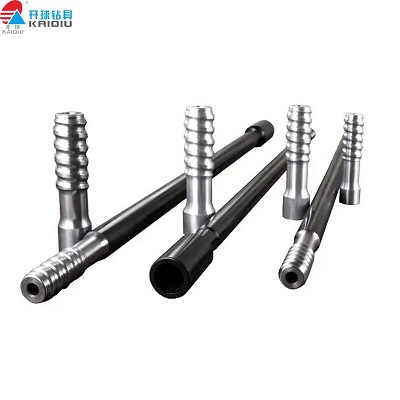Abstract:In the realm of drilling operations, two essential components that play a pivotal role in the success of the task are th...
In the realm of drilling operations, two essential components that play a pivotal role in the success of the task are the drill pipe and button bits. These key elements are instrumental in excavating through the earth's surface and, when used in conjunction with the right practices, can make a significant difference in terms of efficiency, precision, and safety.

Drill Pipe: The Backbone of Drilling
Drill pipes are the robust steel tubes that connect the drilling rig to the drilling bit, allowing for the transfer of power and torque from the surface to the subsurface. The proper operation of drill pipes is crucial for the success of any drilling operation. Here are some essential operating guidelines:
1. Inspection and Maintenance: Before every use, inspect the drill pipe for any signs of wear, corrosion, or damage. Any damaged sections should be replaced immediately. Regular maintenance is vital to ensure the longevity of the drill pipe.
2. Connection and Handling: When connecting and disconnecting the drill pipe, take care to avoid cross-threading. Ensure that the threads are clean and lubricated. Handle the pipe with care to prevent bending or kinking, which can lead to structural weaknesses.
3. Torque and Tension: Follow the manufacturer's specifications for the correct torque and tension values when connecting the drill pipe sections. Over-torquing can damage threads, while under-torquing can lead to poor drilling performance.
4. Handling and Storage: Store drill pipes in a dry, well-ventilated area. Avoid exposure to extreme temperatures and corrosive substances. Storing the pipes on pipe racks or stands is recommended to prevent deformation.
Button Bits: Cutting Through the Earth
Button bits are the business end of the drilling operation, designed to cut through rocks, soil, and other subsurface materials. Operating them efficiently is essential for achieving drilling objectives. Here are some key guidelines:
1. Bit Selection: Choose the appropriate button bit for the specific drilling task. Factors such as rock type, hardness, and drilling depth should be considered. Using the wrong bit can lead to inefficiency and excessive wear.
2. Cooling and Lubrication: Button bits generate a significant amount of heat during operation. Adequate cooling and lubrication are essential to prevent overheating and extend bit life. Ensure that the drilling fluid or air system is functioning correctly.
3. Drilling Parameters: Pay close attention to drilling parameters, including rotation speed, weight on bit (WOB), and penetration rate. Adjust these parameters as needed to optimize drilling efficiency and bit life.
4. Maintenance: Regularly inspect the button bits for wear, damage, or dullness. Dull bits should be replaced promptly to maintain drilling efficiency. Bits can often be reconditioned or repaired, so consider this option when applicable.
5. Safety Measures: Always follow safety protocols when handling and changing button bits. Wear appropriate personal protective equipment and be cautious during bit changes to prevent accidents.
In conclusion, the successful operation of drill pipe and button bits requires a combination of technical knowledge, experience, and a commitment to safety. By adhering to the guidelines mentioned above, drilling professionals can maximize the efficiency and precision of their operations while ensuring the longevity of these essential components. Additionally, proper maintenance and care of drill pipe and button bits can result in significant cost savings and reduced downtime, benefiting both the operation and the environment. As the drilling industry continues to evolve, these practices will remain fundamental in achieving drilling success.

 简体中文
简体中文 English
English España
España русский
русский
